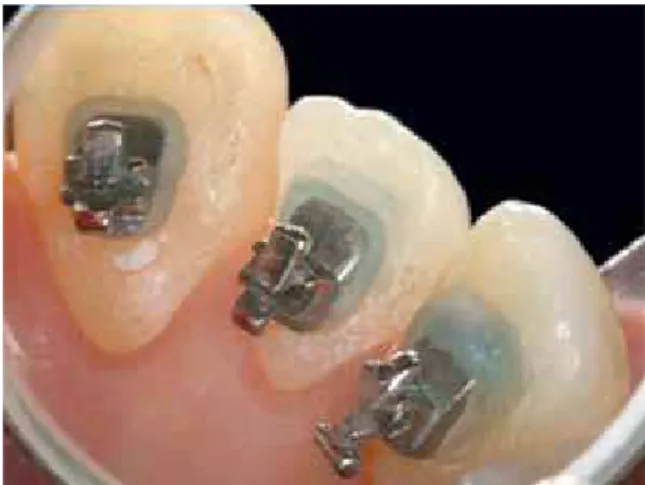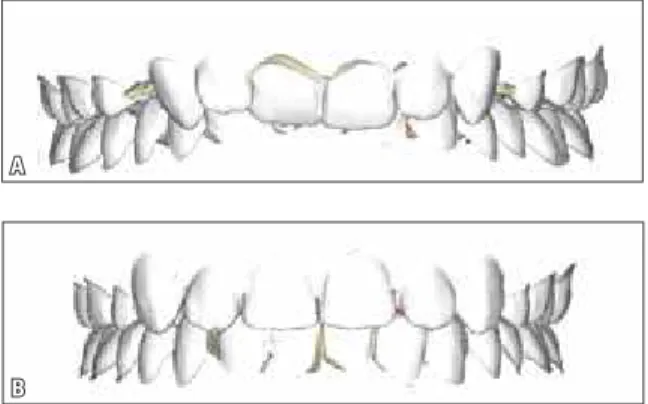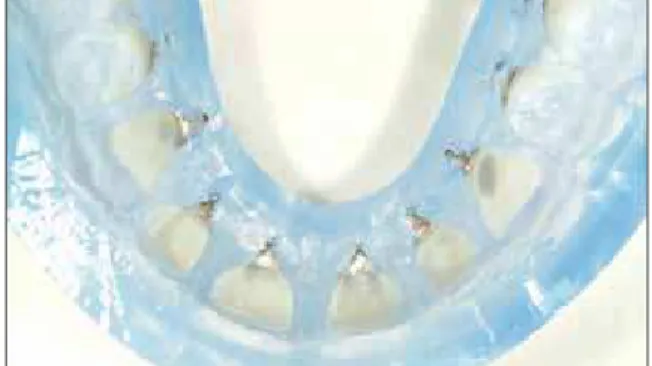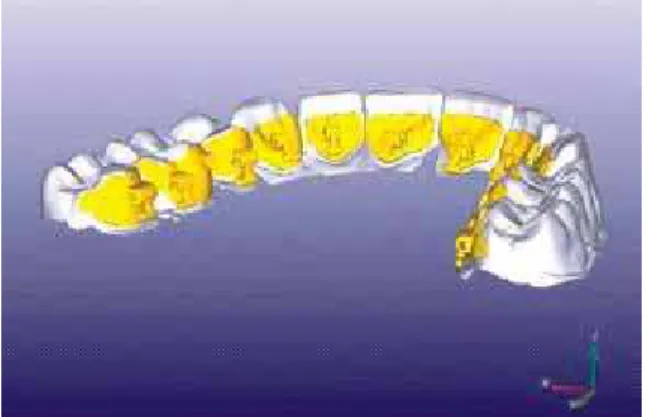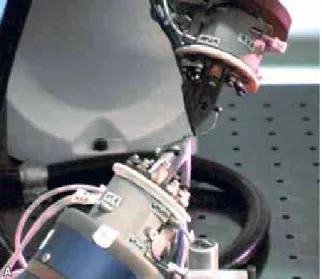Digital technologies and CAD/CAM systems
applied to lingual orthodontics: The future is
already a reality
Lingual orthodontics has been gaining space around the world due to its particularity to offer a discreet treatment option, “invisible”, in “secret” for the correction of malocclusion, combining biomechanical efficiency and enhancement of the smile during treatment.
As the brackets are on the lingual surface, the point of force application is closer to the cen-ter of resistance, maximizing the potential of in-duced tooth movement, which results in faster clinical achievements and significant control over the mechanics.
A landmark study was published in 2001,by Dr. Scuzzo and Dr. Takemoto,9 which gave new perspective to lingual orthodontics describing the possibility of permanently eliminating compen-sating bends, with a Straight-Wire system, based on differential bracket positioning, placed more to the cervical region of the tooth. Within this context, the PSWb6 (Prieto Straight-Wire brack-ets), a Brazilian bracket that is now in its third generation, was developed based on three prin-ciples: more cervical bonding (base without gin-gival extension beyond the slot, higher gingin-gival wing far from the gums), anterior bracket profile slightly increased (compensation for the Straight-Wire technique can be possible); distal offset in the canine bracket, the second premolar bracket with its profile slightly higher than the first pre-molar bracket. It is important to mention that this
bracket enables the simplified indirect bonding technique as a routine in orthodontics practice, facilitating bonding, mechanics during treatment and finishing (Fig 1).
The development of new technologies in image scanning and digital programs enabled the emer-gence of systems based on an ideal digital setup as reference for bracket positioning with remark-able accuracy by eliminating laboratory steps and, therefore, the chances of errors in them.
The Orapix® system represents a major ad-vance and was the result of a partnership between a company in South Korea and Dr. Fillion,2 al-lowing the use of the Straight-Wire technique in lingual orthodontics, with any kind of brackets, Carla Maria Melleiro Gimenez*
* MSc and PhD in Orthodontics, FOA-UneSP.
a
B
and with high precision for their positioning. By scanning the malocclusion models (CAD/CAM) and image capturing by 3TXer software, an ideal virtual numeric setup is built from the data of the orthodontic planning (Fig 2). There is the possibil-ity for the orthodontist to check the virtual setup, or build his/her own setup if he/she prefers (Fig 3). At this stage, the selected brackets are arranged in groups on the digital setup and approximated
as much as possible tothe lingual aspect (Fig 4). Then, each bracket is checked individually with necessary corrections made in three dimensions. From this point on, the virtual data will be trans-ferred to real malocclusion models by transfer jigs previously arranged on the virtual bracket by the 3TXer software (Fig 5) and lately prototyped in resin. There are two parts in these jigs: one that is attached to the bracket slot and one that fits the buccal surface. Therefore, placing the brackets in these jigs and taking them to the malocclusion model, they adjust in a very reliable way and the space left between the bracket and the lingual surface of the model is filled with resin, forming the pads (Fig 6). Usually, the extension is made of resin, copying the lingual surface and forming the KommonBase5, which ensures great adjustment, appreciably reducing debonding events. With the Memosil (Heraeus Kulzer) forming partial trays or with resin custom trays, the indirect bonding is made in the patient’s mouth (Fig 8).
FIGURE 2 - a) Initial scanned model and B) virtual setup of the Orapix System.
FIGURE 3 - Virtual setup checking.
FIGURE 5 - Virtual transfer jig.
FIGURE 4 - Brackets arranged together for the Straight-Wire technique.
a B In this system, the orthodontist has the
re-sponsibility of taking impressions of the patient, sending the dental cast made of special plaster to an Orapix® center, as well as the planning forms filled in detail (describing approach, strategies, type of brackets, sequence of wire and type of anchorage). Planning is important in directing the setup, which is what allows individualiza-tion and excellence in the results. After receiving the mounted case, indirect bonding is done and mechanics starts. Finishing is significantly stream-lined, and everything once planned on the setup is now obtained as clinical outcome (Fig 9).
Another interesting system is the Incognito®, currently distributed by 3M. This system, de-signed by Dr. Wiechmann, is also based on a setup, however, this is done in a conventional way, with great quality control. Nevertheless, the orthodon-tist does not have access to its checking. Later, the setup is scanned (Fig 10) and the image is cap-tured by a specific software on which accessories
are designed by copying the lingual surfaces of the teeth (Fig 11). These “custom brackets” are made of a metal alloy which contains gold in its com-position and require the same casting process of the prosthetic parts (Fig 12). As gold is a noble metal, it allows low-friction, easier sliding of the wires, polishing associated with this sliding, which theoretically provides a favorable biomechanical system. Yet, it is a system that prioritizes the com-pensation of the anatomical differences of lingual aspects based on compensating bends, with no possibility of working with straight wires. These bends are performed by robots, with excellent precision, and are difficult to be reproduced by the orthodontist (Fig 13). The orthodontist takes impressions of the patient with elastomeric mate-rial, sends the impression and the detailed plan-ning to the company, and subsequently he/she will receive the custom appliance ready for bond-ing, as well as the sequence of wires. This is one of the most widely spread systems around the world.
FIGURE 7 - Resin extension – Kommon Base.
FIGURE 9 - Precise setup (a) in relation to the final result (B).
a
C
B
D FIGURE 10 - Setup being scanned for the Incognito system.
FIGURE 12 - Casting process of brackets.
FIGURE 11 - Custom accessories: copy of the lingual surface.
The Lingual Jet® system—developed in asso-ciation with Dr. Gualano and Dr. Baron1, by the same Korean company that developed the Ora-pix® (in association with Dr. Fillion)—represents a mid-point between the two systems described previously, mixing their main characteristics. The aspects in common with the Orapix system is the fact that they are based on an ideal virtual nu-meric setup, and display accessories in such a way
to allow the use of straight wires for orthodontic mechanics (Fig 14), and the orthodontist has ac-cess to the setup.
a B
a B
FIGURE 13 - a) Robots bending the wires and B) individualized archwire.
FIGURE 14 - a) Lingualjet System enabling work with straight wire. B) Lingualjet System with custom brackets.
allergies, aesthetics and biomechanics). The dis-patch process is the same, the orthodontist has to send the patient’s models together with the detailed and sequential planning, and then the custom appliance will be sent for bonding and se-quence of straight wires.
1. Baron P. Lingualjet. Dentistry Portugal #53. 2009 dez;53. [Acesso em: 2009 jun 12]. Disponível em: <http://www.dentistry.pt>. 2. Fillion D. Clinical advantages of the Orapix-straight wire lingual
technique. Int Orthod. 2010 Jun;8(2):125-51.
3. Fujita K. new orthodontic treatment with lingual brackets and mushroom archwire technique. Am J Orthod. 1979;76: 657-75. 4. Hiro T, Takemoto K. Resin core indirect bonding system-
improvement of lingual orthodontic treatment. J Jpn Orthod Soc. 1998;57:83-91.
5. Komori A, Fujisawa M, Iguchi S. KommonBase for precise direct bonding of lingual orthodontic brackets. Int Orthod. 2010 Mar;8(1):14-27.
6. Lago Prieto MG, Ishikawa en, Prieto LT. A groove-guided indirect transfer system for lingual brackets. J Clin Orthod. 2007 Jul;41(7):372-6.
REFERENCES
7. Scuzzo G, Takemoto, K. Invisible orthodontics: current concepts and solutions in lingual orthodontics. Berlin: Quintessenz-Verl; 2003.
8. Scuzzo G, Takemoto K, Mostardi G. Simpliied approach to lingual orthodontics – STb bracket light lingual system. Rev Orthop Dento Faciale. 2007;41:27-36.
9. Takemoto K, Scuzzo G. The Straight-Wire concept in lingual orthodontics. J Clin Orthod. 2001 Jan;35(1):46-52.
10. Wiechmann D, Gerss J, Stamm T, Hohoff A. Prediction of oral discomfort and dysfunction in lingual orthodontics: a preliminary report. Am J Orthod Dentofacial Orthop. 2008 Mar;133(3):359-64.
Contact address
